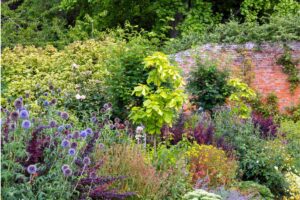Creating a beautiful garden doesn’t have to mean spending hours each week on upkeep. A low-maintenance garden can offer stunning aesthetics with minimal effort, allowing you to enjoy your outdoor space without the constant work. Tony Harding, a professional garden designer and consultant, offers expert garden design services, gardening lessons and presentations, and personalised consultations in the East Midlands and Warwickshire. Here are some tips and tricks for designing a low-maintenance garden.
Choose the Right Plants
Selecting plants that are well-suited to your garden’s conditions is essential for low-maintenance gardening. Opt for native and drought-tolerant plants that require less water and care. Perennials are a great choice as they come back year after year, reducing the need for replanting. Tony Harding’s Garden Design Service can help you choose the best low-maintenance plants for your specific garden conditions.
Use Mulch
Mulching is a simple yet effective way to reduce garden maintenance. It helps retain soil moisture, suppress weeds, and improve soil health. Organic mulches, such as wood chips, straw, or compost, gradually break down and add nutrients to the soil, further benefiting your plants.
Implement Smart Irrigation
Efficient irrigation systems can save you time and water. Drip irrigation or soaker hoses deliver water directly to the plant roots, reducing evaporation and ensuring your plants get the moisture they need. Consider installing a timer to automate watering, making it even easier to keep your garden hydrated.
Group Plants by Watering Needs
Grouping plants with similar water needs together can make watering more efficient and effective. This practice, known as hydrozoning, ensures that each plant receives the appropriate amount of water without wasting resources.
Minimise Lawn Areas
Lawns require regular mowing, watering, and fertilising, making them high-maintenance. Reduce the size of your lawn or replace it with ground covers, native grasses, or hardscaping elements such as gravel or paving. These alternatives are not only low-maintenance but also add texture and visual interest to your garden.
Opt for Slow-Growing Plants
Slow-growing plants require less pruning and trimming, reducing the time you need to spend on maintenance. Choose shrubs and trees that grow slowly and maintain a compact shape, keeping your garden tidy with minimal effort.
Create Defined Edges
Clearly defined garden beds with clean edges can help prevent grass and weeds from encroaching. Use edging materials like stone, metal, or plastic to create a barrier between your lawn and garden beds. This makes it easier to maintain a neat and orderly garden.
Incorporate Hardscaping
Hardscaping elements, such as patios, pathways, and decorative gravel areas, reduce the amount of space that needs to be planted and maintained. These features also add structure and functionality to your garden, making it more enjoyable and usable.
Seek Professional Advice
Designing a low-maintenance garden can be challenging, but professional guidance can make it easier. Tony Harding offers personalised Garden Consultations to help you create a low-maintenance garden tailored to your needs. His expert advice can guide you in making the best choices for a beautiful and easy-to-care-for garden.
Learn and Grow
If you want to learn more about low-maintenance gardening techniques, Tony also provides Gardening Lessons, Presentations & Workshops. These educational sessions cover a variety of topics, helping you gain the knowledge and skills to maintain your garden with ease.
Get in Touch
Ready to design your low-maintenance garden? Contact Tony Harding today for expert advice and support. Reach out via telephone at 07768464167 or via email at info@garden-adviser.co.uk. With Tony’s expertise, you can create a stunning garden that requires minimal upkeep, allowing you to enjoy your outdoor space without the hassle.



